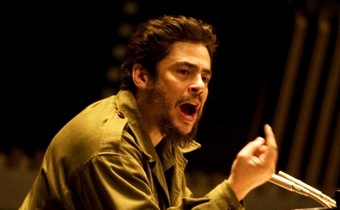 In total, “Che” runs 4.5 hours. Too much for most moviegoers, but not for director Steven Soderbergh. He regrets not extending his guerrilla warfare chronicle to 10 hours — “the miniseries route.”
In total, “Che” runs 4.5 hours. Too much for most moviegoers, but not for director Steven Soderbergh. He regrets not extending his guerrilla warfare chronicle to 10 hours — “the miniseries route.”
In fact, Soderbergh regrets the whole thing.
“I can’t sit here and tell you it was worth it,” the director says of “Che.” “It made me wonder if movies matter anymore.”
The project’s 10-year slog to the screen proves at least as interesting as Soderbergh’s film.
The indie production’s story is told with gusto on the Criterion Collection’s fine Blu-ray release of “Che” — the polarizing film about revolutionary Ernesto Guevara. ($50 retail).
I didn’t see the roadshow version of “Che,” nor the subsequent theatrical releases of its two distinct parts (Cuba and Bolivia). Not many people did, due to the movie’s length, its Spanish-language dialog and the tepid critical reaction.
“Che” lives, though, on home video.
Watching the Blu-rays over two unhurried nights, the movie felt right. The hum of the tropics, the lush visuals, Alberto Iglesias’ haunting music … all filtered through HD and 5.1. The filmmakers sought to “drop viewers into the jungle” and did just that.
“Che’s” leisurely pace — with all that hunkering down in the jungle, smoking cigars and talking Marx — was easy to fall into, there in the chair with pause button at the ready.
Confined in a theater, though, thoughts of mounting an offense against the projection booth surely would have crept in after several hours.
At its heart, “Che” is a guerrilla warfare procedural, guided by the diaries of Guevara. Despite the uncanny title performance of Benicio Del Toro, the movie must be witnessed for the immersive experience, not its scarce entertainments.
“Che” tells of two campaigns from the revolutionary career of its Argentine hero. One triumphant: the taking of Cuba with Fidel Castro — the other disastrous: a jinxed, unwelcome attempt to “liberate” Bolivia.
Any creative work about Guevara is sure to inflame passions, but Soderbergh ensured his film’s notoriety with the decision to end part 1 as the rebels reached the outskirts of Havana.
This meant no mention was made of Guevara’s kangaroo-court executions of hundreds of Cubans after the Castro victory — earning him the nickname the Butcher of La Cabana, and the eternal hatred of the Cuban exile community.
In the Blu-ray set’s extra features, Soderbergh lamely dismisses this part of Guevara’s life as “time behind the desk.”
Biographer Jon Lee Anderson (“Che Guevara: A Revolutionary Life”) has plenty of beefs with the movie and its “glaring gaps” in Guevara’s story. He shares his views on a 4.5 hour commentary track, one of the longest in home video history.
Anderson complains, for example, that the movie ignores Guevara’s transition from a poet and doctor to a didactic warrior. (Roughly, the space between “The Motorcycle Diaries” and “Che.”) The rebel leader’s humiliating misadventure in the Congo also is MIA.
Anderson also greatly admires Guevara, noting that the “ultimate rebel” made long hair cool. But the portrait that emerges from this talk — essentially two long informal lectures — is far more balanced than the movie’s.
The box set’s excellent making-of documentary makes it clear that the people who made this film went into the project knowing next to nothing about their subject. Hands-on producer Laura Bickford had “seen his photo.” Still, Soderbergh says every scene in the film was relentlessly sourced — “authenticity trumps everything.”
“Che’s” first part provides welcome contrast with cut-ins of grainy black-and-white glimpses from Guevara’s trip to Manhattan — a study in radical chic. The filmmakers shot the scenes before they knew there would ever be a movie.
The U.N. was about to remodel, and the filmmakers rushed to capture Del Toro giving Guevara’s speech in the familiar main hall before it was gutted.
Soderbergh talks about the movie’s perceived failures and frets about the damage done to some co-workers’ reputations.
“I don’t think there’s a sense that a movie can be polarizing and that could be a good thing,” the director says. “Imagine what ‘2001’ would have gotten on Rotten Tomatoes.” (“Che” gets 63 percent.)
The Criterion Blu-ray set also has a half-hour 1967 film about Guevara’s death in Bolivia, made by a journalist who was on the scene. It includes grisly footage of soldiers showing off the guerrilla’s corpse.
“Che’s” use of the new RED digital camera makes for another adventure story, told in a separate documentary.
The lightweight 4K camera became operational just hours before Soderbergh and company shot their first big action scene, employing 800 extras. The super-high-resolution camera sucked up natural light, giving the movie much of its beauty; its light weight allowed for handheld filming of the Bolivian scenes.
Soderbergh, who does his own cinematography, shot the Cuban chapter in 2.39:1, saturating the visuals with tropical colors. For the claustrophobic Bolivian chapter, he went with a 1.78:1 aspect ratio, draining off much of the color.
Other extras in the “Che” Blu-ray set include extra scenes on both discs, the best being a revolutionary murder trial. There are also interviews with historians and survivors of the two campaigns, a handsome booklet with a written essay by Amy Taubin and the trailer.
Criterion’s “Che” also comes in a three-disc DVD set (also $50), with identical extras.
Check out Glenn Abel on Google+
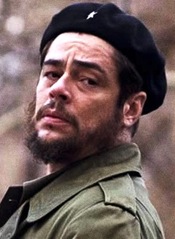
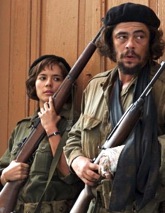

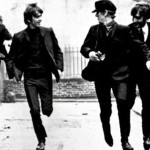
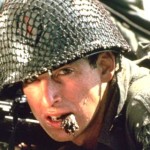
Leave a Reply